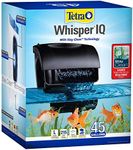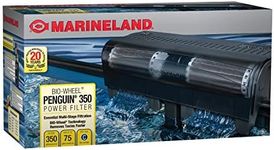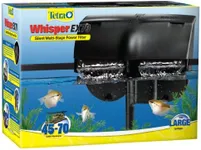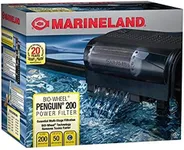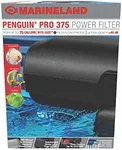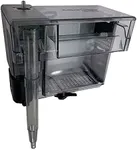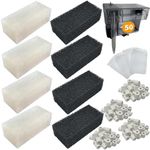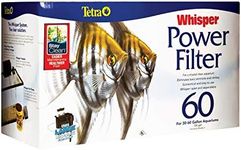Buying Guide for the Best Fish Filter For 50 Gallon Tanks
Choosing the right fish filter for your 50-gallon tank is crucial for maintaining a healthy and clean environment for your aquatic pets. A good filter will help remove waste, toxins, and debris from the water, ensuring that your fish thrive. When selecting a filter, consider the following key specifications to make an informed decision that best suits your needs and the needs of your fish.Filter TypeThere are several types of filters available, including hang-on-back (HOB), canister, sponge, and internal filters. Each type has its own advantages and is suitable for different setups. HOB filters are easy to install and maintain, making them a popular choice for beginners. Canister filters offer superior filtration and are ideal for larger tanks or heavily stocked aquariums. Sponge filters are great for breeding tanks or tanks with small, delicate fish, as they provide gentle filtration. Internal filters are compact and fit inside the tank, making them suitable for smaller spaces. Choose a filter type based on your tank setup, the type of fish you have, and your maintenance preferences.
Flow RateThe flow rate of a filter, measured in gallons per hour (GPH), indicates how much water the filter can process in an hour. For a 50-gallon tank, a good rule of thumb is to choose a filter with a flow rate that can turn over the tank's water at least 4-6 times per hour. This means you should look for a filter with a flow rate of 200-300 GPH. If you have a heavily stocked tank or fish that produce a lot of waste, you might want to opt for a higher flow rate. Conversely, if you have delicate fish that prefer calmer waters, a lower flow rate might be more appropriate.
Filtration StagesFilters typically offer three stages of filtration: mechanical, chemical, and biological. Mechanical filtration removes physical debris from the water, chemical filtration uses activated carbon or other media to remove toxins and impurities, and biological filtration relies on beneficial bacteria to break down harmful ammonia and nitrites. A good filter should provide all three stages to ensure comprehensive water purification. When choosing a filter, consider one that offers multi-stage filtration to maintain optimal water quality in your tank.
MaintenanceRegular maintenance is essential to keep your filter running efficiently. Some filters are easier to clean and maintain than others. HOB and internal filters are generally easier to access and clean, while canister filters may require more effort but offer superior filtration. Consider how much time and effort you are willing to invest in maintaining your filter. If you prefer low-maintenance options, look for filters with easy-to-replace media and straightforward cleaning processes.
Noise LevelThe noise level of a filter can impact the overall enjoyment of your aquarium. Some filters operate more quietly than others, which can be important if your tank is located in a living space or bedroom. HOB and internal filters tend to be quieter, while some canister filters may produce more noise due to their powerful motors. If noise is a concern for you, look for filters that are specifically designed to operate quietly or have features that reduce noise.
Size and CompatibilityEnsure that the filter you choose is compatible with your 50-gallon tank in terms of size and design. Some filters may be too large or bulky for certain tank setups, while others may not fit properly with your tank's dimensions. Check the manufacturer's specifications to ensure that the filter will fit comfortably in your tank and work effectively with your aquarium's layout. Compatibility with other equipment, such as heaters and air pumps, is also important to consider.

